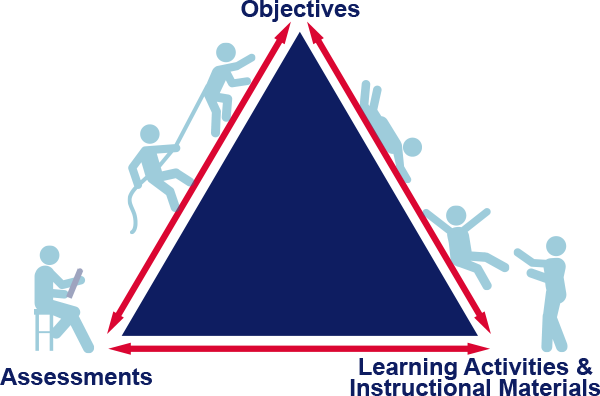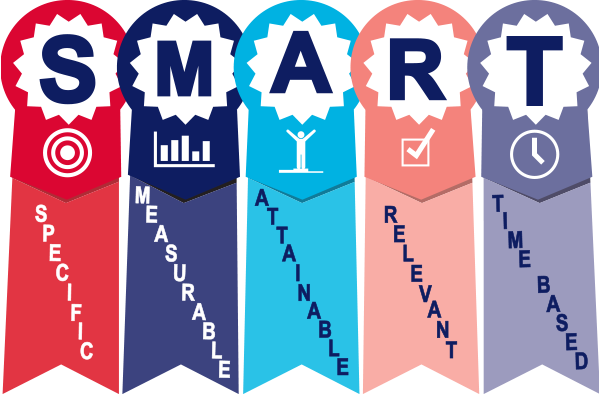
Learning Objectives are a description of significant and essential learning that learners have achieved and are reliably able to demonstrate upon completion of an educational activity. A well-written learning objective outlines the knowledge, skills and/or attitudes the learners will gain from the educational activity. (Chatterjee, D., & Corral, J. 2017).

Note: While it is optimal to include all three components in a learning objective, it is not necessary or always feasible to include conditions or criterion in each learning objective.
The term learning objectives is sometimes used interchangeably with the terms course goals, learning outcomes, or teaching objectives.
Course goals are broad statements of what you want students to learn. Course goals, sometimes referred to as course-level learning objectives, may use verbs associated with outcomes that are not readily observable and do not lend themselves easily to measurement (e.g., know, understand, value, appreciate). Examples of statements that can be considered course goals are: “Understand the process of scientific inquiry” and “Appreciate the intangible benefits of art in society.” Course goals can be integrated into the “course description” of a syllabus, providing students with broader context such as relevance, connection to real life, and motivational or aspirational drivers for taking a particular course.
Learning outcomes are used to describe what a student knows or is able to do as a result of completing a learning experience, whether at the course, module/unit, or assignment level. Learning outcomes are intended to be more synonymous with learning objectives than course goals or teaching objectives.
Teaching objectives are statements written from an instructor’s perspective, providing the content, context, and direction of instruction. Teaching objectives are very helpful in creating lesson plans for your course.
The terms goals, objectives, and outcomes often are used interchangeably. Although all are related to the teaching and learning taking place in a course, the emphasis differs as to the scope and scale of the learning. This teaching guide will focus on writing learning objectives.
Learning objectives can give students a clear picture of what to expect and what’s expected of them.
Learning objectives can communicate what is important to their learning. Without learning objectives it can be difficult for students to know what they are supposed to be learning and where they should be paying particular attention. Well-written learning objectives can facilitate efficient and more effective study methods by students.
Well-designed learning objectives can help students learn new materials in such a way that they can flexibly and appropriately use it in a variety of contexts, both in the short term and down the road. This is known as “transfer,” which is a key indicator of deep learning (Barnett & Ceci, 2002).
Learning objectives can help students build metacognitive skills. Metacognition is the “the process of reflecting on and directing one’s own thinking” (National Research Council, 2001). Self-directed learning consists of assessing the learning objectives, taking stock of one’s own knowledge and skills, planning one’s approach to learn the material, monitoring one’s progress, and adjusting learning strategies as needed (Hammond and Collins 1991)
Learning objectives help instructors select appropriate instructional materials and organize course content. The use of well-defined, actionable learning objectives leverages your ability to assess texts or activities for their relevance and suitability.
Learning objectives help instructors build assessments that are aligned with the learning activities or instructional materials included in the course. Alignment is the degree to which learning objectives, assessments, and learning activities and instructional materials work together to achieve desired learning goals. Well-articulated learning objectives make clear that you are assessing materials that were covered in the course and make the creation of assessment items easier for you. Check your learning objectives for alignment with assessments, and if they are not well aligned, revise the objectives as needed.
Articulating learning objectives is an essential step in ensuring course alignment of three key components:
Please review the Backward Design Teaching Guide to learn more about alignment of learning objectives, assessments, and learning activities/instructional materials.

The three key components.
Next, identify knowledge or skills that students should learn, or changes in attitudes you are hoping to see,by the end of the course, module, or learning activity.
Now would be the time to review your course-level objectives or broader learning goals and craft weekly or modular-level learning objectives that align with your course objectives or goals.
Then, choose an action verb to reflect an observable, measurable outcome or behavior that aligns with the desired knowledge or skills identified above.
Learning taxonomies can be a useful tool for identifying action verbs that create specific and measurable learning objectives. Bloom’s Taxonomy Of Educational Objectives is a framework for classifying learning objectives (1956). Bloom identified three domains of educational activities or learning: cognitive, affective, and psychomotor. Bloom then assigned to the cognitive domain a system of learning made up of six levels of learning: remember, understand, apply, analyze, evaluate, and create. A full discussion of Bloom’s Taxonomy is available in the CATE Teaching Guide, but referring to the Bloom’s Taxonomy Verb Chart on its own is a great starting point to brainstorm action verbs that align with the learning you want to facilitate in your courses.
An alternative to Bloom’s is Fink’s Taxonomy of Significant Learning (2003; revised 2013). Like Bloom’s taxonomy, Fink’s is composed of six categories of learning, which are:
However, unlike Bloom’s taxonomy, Fink’s is non-hierarchical, with each element interacting with one another to “create significant learning,” or an impact a course continues to have on students a couple of years after it is over. Each kind of learning can stimulate any of the other kinds of learning. For a concise list of action verbs aligned to Fink’s six categories of learning, consult the document Fink’s Taxonomy Learning Objectives.
When crafting learning objectives, avoid using verbs such as “learn,” “become,” “know,” or “understand.” As discussed earlier in this teaching guide, course-level objectives or learning goals may include verbs not readily observable and which do not lend themselves easily to measurement, but learning objectives at the unit, module, or lesson level should reflect more measurable and observable actions or behaviors.
Make sure that each learning objective includes only one action verb and one specific aspect of expected performance or behavior. For example, a learning objective that includes the two-verb phrase “…draft and revise an essay…” should be broken down into two learning objectives specific to each action verb or should be drafted in a way that better reflects the entire essay crafting process rather than granular components of the writing assignment.
Specify the condition in which the performance or behavior will occur.
Example: In this learning objective: “After reviewing CATE’s learning objectives teaching guide, you will be able to craft measurable and observable learning objectives,” the condition is “After reviewing CATE’s learning objectives teaching guide.”
In summary, you should make sure that each learning objective answers the following questions:
The mnemonic SMART — Specific, Measurable, Attainable, Relevant, and Time-based — serves as a guide when crafting effective learning objectives.

The mnemonic SMART
The learning objective should be well-defined and clear. Make sure the learning objective is specific to the lesson and is specifically stated. Avoid using verbs that are vague and cannot be observed, such as appreciate, know, or believe. Be specific about how a student will demonstrate their learning.
Learning objective example lacking specificity: By the end of this session, the student will be able to study Einstein’s theory of relativity.
Learning objectivity revised for specificity: By the end of this session, the student will be able to cite examples in support of Einstein’s theory of relativity.
MEASURABLEThe learning objective should both describe what a student will do, as well as exactly how the learning will be measured and evaluated.
Example of an unmeasurable learning objective: By the end of the lesson, learners will know the causes of the Second World War.
Learning objective revised for measurability: By the end of the lesson, students will be able to recount a timeline of the events leading up to the Second World War.
ATTAINABLECan the objective be accomplished in the proposed time frame with the available resources and support? Do the students have the prior learning necessary to accomplish the objective? Unrealistic expectations or goals for the completion of a learning objective are self-defeating for both the student and the instructor.
Example of an unachievable learning objective: By the end of the lesson, students will be able to research the European Union.
Revised learning objective: By the end of the lesson, students will be able to describe the organization of the European Union.
Does the objective address the overall program goal(s)? Will the objective have an impact on the goal(s)? Ensuring that all learning objectives are relevant to a specific lesson entails careful course design.
Mapping out your course is a great way to make sure that all course objectives are relevant to the lesson and that learning materials, activities, and assessments all work together. See CATE’s course map template for more information on getting started on your own course map.
TIME-BASED OR TIME-BOUNDA learning objective should include a specific time by which it will be completed, such as by the end of a lesson, module, or course.
It is important to allow enough time in the lesson, module, or course to complete the steps needed to achieve the objective (Skrbic and Burrows, 2015).
Class size has an impact on the effectiveness of your learning objectives and guides how you craft your learning objectives. According to a study conducted by Taft, Kesten, and El-Banna, instructors of large classes (more than 40 students) are more likely to emphasize learning foundational and factual knowledge and are less likely to stress developing oral and written communication skills. On the other hand, instructors of small classes (fewer than 15 students) are more likely to emphasize mastery of complex knowledge and student skill development (2019).
Studies have also shown that instructors in small and medium classes are more likely to involve students in hands-on projects and real-life activities, assign projects that require original or creative thinking, form teams or discussion groups to facilitate learning, and ask students to help each other understand concepts or ideas (Benton and Pallett 2013). As you are crafting your learning objectives for your course, keep in mind that class size may have some impact on the learning activities and assessments that work best, which will then impact course learning objectives. You may want to consider implementing group work or team-based learning in your larger size courses to facilitate more student collaboration.
The course modality – on-campus, online synchronous, online asynchronous, hybrid, synchronous distributed – used in a course does not have a direct or immediate impact on how you craft your learning objectives. However, course modality does impact how you will assess student learning, what instructional materials and learning activities are most effective for the course modality, and which edtech tools you would like to use in your course. When crafting learning objectives, think through how you will implement learning activities and assess learning as this will impact your learning objectives as you align your objectives/assessments/learning activities and instructional materials. Please review the collection of Assessment and Grading Practices Teaching Guides to learn more about different ways to assess student learning in courses of all modalities.

Please use the following citation to cite this guide: